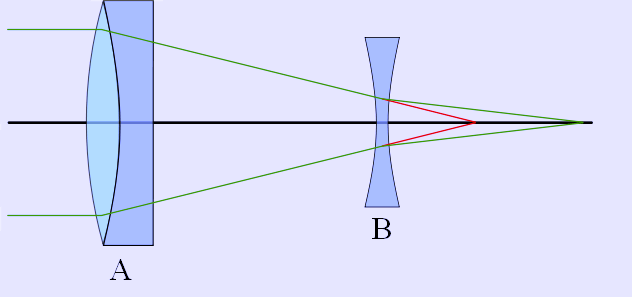.
Barlow lens

A: ocular, B: Barlow lens. Beam of light without (red) and with (green) a Barlow lens
The Barlow lens, named for its creator, the English engineer Peter Barlow, is a diverging lens which, used in series with other optics in an optical system, effectively increases the focal ratio of an optical system as perceived by all components after it in the system.
In its astronomical use, a Barlow lens may be placed immediately before an eyepiece to effectively decrease the eyepiece's focal length by the amount of the Barlow's divergence. Since the magnification provided by a telescope and eyepiece is equal to the telescope's focal length divided by the eyepiece's focal length, this has the effect of increasing the magnification of the image.
Astronomical Barlow lenses are rated for the amount of magnification they induce. Most commonly, Barlow lenses are 2×, but 3× Barlows and adjustable Barlows are available. The power of even ordinary Barlow lens is "adjustable": adding an extension tube between the Barlow and the eyepiece increases magnification. The magnification is one more than the number of Barlow focal lengths between the Barlow lens and the eyepiece. If the length of a standard 2× Barlow lens' tube is doubled, it becomes a 3× Barlow, if the tube length is tripled, it becomes a 4× Barlow, and so on.
In microscopy the Barlow lens is used to increase working distance and decrease magnification. The lens are "objective lenses" that are mounted in front of the microscope's last objective element. Standard lenses are 2× which decreased the working distance by half and increases the magnification, .75× which increases the working distance proportionally to the .75 and decreases the magnification similarly. A .5× would double the working distance and half the magnification.
Retrieved from "http://en.wikipedia.org/"
All text is available under the terms of the GNU Free Documentation License

